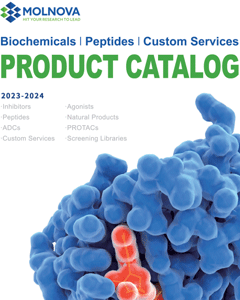 Home -
Products -
Proteasome/Ubiquitin -
Endogenous Metabolite -
Glucagon-Like Peptide (GLP) II, human
Home -
Products -
Proteasome/Ubiquitin -
Endogenous Metabolite -
Glucagon-Like Peptide (GLP) II, human

Glucagon-Like Peptide (GLP) II, human
Glucagon-Like Peptide (GLP) II, human
Catalog No. M30186
Glucagon-like peptide 2 (GLP-2) is a recently identified intestinal epithelium-specific growth factor that has been shown to reduce the severity of inflammatory disorders of the intestine in rodent models. Currently Glucagon-Like Peptide 2 is used as a potential therapeutic agent for the human subjects with a broad variety of intestinal diseases characterized by intestinal damage and insufficiency.
| Size | Price / USD | Stock | Quantity |
| 100MG | Get Quote | Get Quote |


|
| 200MG | Get Quote | Get Quote |


|
| 500MG | Get Quote | Get Quote |


|
Biological Information
-
Product NameGlucagon-Like Peptide (GLP) II, human
-
Brief Description
-
Description
-
Storage
-
NoteResearch use only, not for human use.
-
ReferenceDrucker DJ, et al. Induction of intestinal epithelial proliferation by glucagon-like peptide 2. Proc Natl Acad Sci U S A. 1996 Jul 23;93(15):7911-6.



-
Campesterol
Campesterol is a plant sterol with cholesterol lowering and anticarcinogenic effects, it and other plant sterols often decrease LDL cholesterol levels overall. Campesterol has anti-inflammatory effect, it inhibits several pro-inflammatory and matrix degradation mediators typically involved in osteoarthritis- induced cartilage degradation, also sometimes used to treat some specific prostate conditions.
-
1-Methyl-6-oxo-16-di...
1-Methyl-6-oxo-16-dihydropyridine-3-carboxamide is one of the end degradation products of nicotinamide-adenine dinucleotide (NAD).
-
Glutaric acid
Glutaric acid is a simple five-carbon linear dicarboxylic acid. Glutaric acid is naturally produced in the body during the metabolism of some amino acids including lysine and tryptophan. Glutaric acid may cause irritation to the skin and eyes. When present in sufficiently high levels glutaric acid can act as an acidogen and a metabotoxin.



 Cart
Cart
 sales@molnova.com
sales@molnova.com

